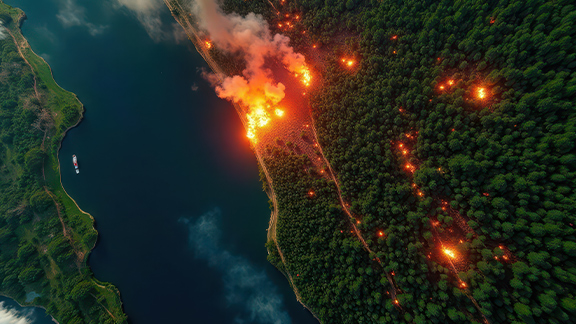The forests in Thailand are diverse and important for the ecosystem and people's way of life. However, the country's forest area has been steadily declining. According to the latest data, Thailand will still have 101,818,155.76 rai of forest in 2023, which is 31.47 percent of the country's land area. This is a decrease from 2022, when the forest area was 102,135,974.96 rai or 31.57 percent of the country's land area.

Retrieved from https://www.seub.or.th/bloging/work/2014-113/
The forest types in Thailand are divided into 2 types

Retrieved from https://www.dnp.go.th/research/knowledge/type%20of%20forest.html
1. Deciduous forest
This is a forest that sheds its leaves seasonally. It is often found in regions with a long dry season of 4-7 months. At the beginning of the dry season, when the moisture in the soil and atmosphere drops sharply, the trees of this type of forest shed their leaves and fall to the ground. When the rainy season begins, the trees in this forest prepare to sprout new leaves. Most of the vegetation in the deciduous forest consists of deciduous species. In the dry season, the trees shed their leaves, causing dry leaves to accumulate, which increases the risk of forest fires. Deciduous forests in Thailand include:

1.1 Mixed Deciduous Forest
Is an open forest in which various species of bamboo are scattered. Almost all trees shed their leaves during the dry season, especially from late January to April. In Thailand, this type of forest is found in the northern, central and northeastern regions covering the upper part of Prachuap Khiri Khan province. This forest type occurs at an altitude of 50-800 meters above mean sea level, higher in some areas, with rainfall of 1600 millimeters per year or less in the range of 1200-1400 millimeters per year. The soil is usually sandy loam.

1.2 Deciduous Dipterocarp Forest
The general characteristics are open forests occurring at an altitude of 50-1000 meters above mean sea level. The amount of precipitation is between 900and 1200 millimeters per year. Forest fires occur frequently in this type of forest. The dry areas are sandy loam soils or gravel, laterite, which are often found in the plains and mountains. In the north, they are mainly found in the mountains with shallow and very dry soils. The north-east has the most deciduous dipterocarp forests.
1.3 Savanna
Is a plant community from the mixed deciduous forest group, consisting of small trees or shrubs and grasses that alternately cover the area. There are very few natural savannah forests in Thailand. Most of them are the result of forest degradation, which leads to the expansion of grasslands every year. They occur in areas with less than 900 millimeters of rainfall per year.
1.4 Tropical Grassland and Savanna
Are plant communities that are very similar both in their structure and in their plant species. They consist mainly of grasses. There are large areas that are completely covered with grasses. Some other herbaceous plants may also be mixed in. There are only a few natural tropical grasslands in Thailand, and most of them are very small. Therefore, not much attention is paid to them.
2. Evergreen forest
This type of forest is moist all year round, as most of the trees are evergreen and located in areas with high humidity. Evergreen forests are generally divided into different types according to climate and topography.

2.1 Moist Evergreen Forest
Is a dense forest that looks green all year round. In areas with a rainfall of more than 1,600 millimeters per year, it rains continuously for more than 8 months a year. There are hundreds of plant species. They are generally found from an altitude of 600 meters above mean sea level scattered in all regions of the country, but most are found on the east coast, such as Rayong, Chanthaburi and the south.

2.2 Dry Evergreen Forest
Is a forest that lies in a relatively flat area or in a valley. It has little moisture and a dry season of about 3-4 months. The soil is quite deep and can store water well. It grows at an altitude of 100-800 meters above mean sea level and has a rainfall of 1000-2000 millimeters per year.

2.3 Hill Evergreen Forest
This type of forest occurs at high altitudes or on mountains at an altitude of 1,000-1,800 meters above sea level. The rainfall is between 1,000 and 2,000 millimeters and the weather is cold. It is mainly found on the high mountains in the north and partly in the central and north-eastern regions.

2.4 Pine forests
Can be found on high mountains. The terrain is quite cool and has a fairly long cold season, but it is not too humid. Most of the area is at an altitude of 200 to 1800 meters above sea level. Sometimes there are mixed forests with deciduous dipterocarp forest and evergreen mountain forest. Pine forests are open forests.
2.5 ป่าชายเลน (Mangrove Forest)
Sometimes called "saltwater mangrove forest", there are dense trees of all kinds with supporting and breathing roots. This type of forest is found in muddy areas along the sea or at the mouth of large rivers that are flooded with salt water on both sides of the sea coast in the southern region. Along the eastern seaboard, they are found in all provinces, but are most common at the mouth of the Welu River in Lung District, Chanthaburi Province. Most of the plants in the mangrove forests are small species used to make charcoal and firewood.

2.6 Swamp Forest
This type of forest usually occurs in areas with a lot of freshwater flooding and poorly drained soils. The swamp forests in the central region are open and have widespread tree species. In the south, swamp forests grow in areas with year-round water. The largest area of swamp forests is in Narathiwat province. The soil consists of peat, i.e. decomposed plant remains that have accumulated over a long period of time.
2.7 Beach Forest
Is an evergreen forest that grows along the beach. It is a forest that covers the coastal area where the soil is very sandy and not flooded by the sea, or the area of old sandy beaches that have been filled in, or the rocky area near the coast. The soil is quite salty. Most of the trees that grow on the beach are salt-tolerant plants and tend to be bushy and bent by the wind.




